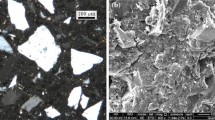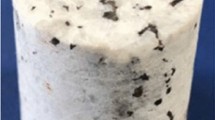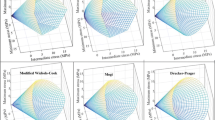Abstract
In this paper, the static and dynamic response of rock engineering models has been investigated using particle flow code. For this purpose, firstly calibration of PFC2D was performed using uniaxial strength and Brazilian tensile strength. After calibration of PFC2D, uniaxial compression test was simulated by creating a rectangular model in PFC2D. The PFC specimen had dimension of 60 mm × 120 mm. The compressive strength of model material was 6 MPa. Rectangular models are subjected under uniaxial loading of 0.1 mm/s, 0.2 mm/s, 0.6 mm/s, 1 mm/s, 2 mm/s, 4 mm/s, 6 mm/s, 8 mm/s, 10 mm/s, 12 mm/s, 14 mm/s, 16 mm/s and 20 mm/s. These models are under confining pressure of 0.5 MPa. Concurrent with uniaxial test, simulation was performed on the rock slope, rock slope consisting a vertical joint and also consisting a central tunnel. Dimension of rock slope is 100 mm × 100 mm. The length of joint was 1 mm × 30 mm, and diameter of tunnel was 20 mm. Totally, 52 models were tested. The results show that failure pattern was affected by loading rate while model strength is affected by failure pattern.











Similar content being viewed by others
References
Akbas S (2016) Analytical solutions for static bending of edge cracked micro beams. Struct Eng Mech Int J 59(3):66–78
Alsaid-Alwan HHS, Avcar M (2020) Analytical solution of free vibration of FG beam utilizing different types of beam theories: a comparative study. Comput Concr 26(3):285–292
Civalek Ö, Avcar M (2020) Free vibration and buckling analyses of CNT reinforced laminated non-rectangular plates by discrete singular convolution method. Eng Comput. https://doi.org/10.1007/s00366-020-01168-8
Cundall PA Strack ODL (1979) A discrete numerical model for granular assemblies. Geotechnique 29(1):47–65
Dai F, Huang S, Xia K, Tan Z (2010) Some fundamental issues in dynamic compression and tension tests of rocks using split Hopkinson pressure bar. Rock Mech Rock Eng 43(6):657–666
Fan Y, Zhu Z, Kang J, Fu Y (2016) The mutual effects between two unequal collinear cracks under compression. Math Mech Solids 22:1205–1218
Gerges N, Issa C, Fawaz S (2015) Effect of construction joints on the splitting tensile strength of concrete. Case Stud Constr Mater 3:83–91
Ghazvinian A, Sarfarazi V, Schubert W (2012) A study of the failure mechanism of planar non-persistent open joints using PFC2D. Rock Mech Rock Eng 45:677–693
Haeri H, Sarfarazi V (2016a) The effect of micro pore on the characteristics of crack tip plastic zone in concrete. Comput Concr 17(1):107–112
Haeri H, Sarfarazi V (2016b) The deformable multilaminate for predicting the elasto-plastic behavior of rocks. Comput Concr 18:201–214
Haeri H, Sarfarazi V, Lazemi HA (2016) Experimental study of shear behavior of planar non-persistent joint. Comput Concr 17(5):639–653
Hao Y, Hao H (2013) Numerical investigation of the dynamic compressive behaviour of rock materials at high strain rate. Rock Mech Rock Eng 46(2):373–388
Huang C, Subhash G, Vitton SJ (2002) A dynamic damage growth model for uniaxial compressive response of rock aggregates. Mech Mater 34(5):267–277
Itasca Consulting Group Inc (2004) Particle flow code in 2-dimensions (PFC2D), Version 3.10, Minneapolis
Itasca PFC2D (1999) Particle Flow Code in 2 Dimensions, Theory and background. Itasca Consulting Group, Minneapolis, pp 1–124
Kim JJ, Taha MM (2014) Experimental and Numerical Evaluation of Direct Tension Test for Cylindrical Concrete Specimens. Advances in Civil Engineering 2014(156926):8 https://doi.org/10.1155/2014/156926
Kequan YU, Zhoudao LU (2015) Influence of softening curves on the residual fracture toughness of post-fire normal-strength mortar. Comput Mortar Int J 15(2):102–111
Lancaster IM, Khalid HA, Kougioumtzoglou IA (2013) Extended FEM modelling of crack propagation using the semi-circular bending test. Constr Build Mater 48:270–277
Lee S, Chang Y (2015) Evaluation of RPV according to alternative fracture toughness requirements. Struct Eng Mech Int J 53(6):1271–1286
Li XB, Lok TS, Zhao J (2005) Dynamic characteristics of granite subjected to intermediate loading rate. Rock Mech Rock Eng 38(1):21–39
Li Y, Zhou H, Zhu W, Li S, Liu J (2015) Numerical study on crack propagation in brittle jointed rock mass influenced by fracture water pressure. Materials 8(6):3364–3376
Li S, Wang H, Li Y, Li Q, Zhang B, Zhu H (2016) A new mini-grating absolute displacement measuring system for static and dynamic geomechanical model tests. Measurement 82:421–431
Liu X, Nie Z, Wu S, Wang C (2015) Self-monitoring application of conductive asphalt concrete under indirect tensile deformation. Case Stud Constr Mater 3:70–77
Lu FY, Lin YL, Wang XY, Lu L, Chen R (2015) A theoretical analysis about the influence of interfacial friction in SHPB tests. Int J Impact Eng 79:95–101
Ma GW, Hao H, Wang F (2011) Simulations of explosion-induced damage to underground rock chambers. J Rock Mech Geotech Eng 3(1):19–29
Marji M (2014) Numerical analysis of quasi-static crack branching in brittle solids by a modified displacement discontinuity method. Int J Solids Struct 51(9):1716–1736
Meyers MA (1994) Dynamic Behavior of Materials. John Wiley and Sons, New York
Mobasher B, Bakhshi M, Barsby C (2014) Backcalculation of residual tensile strength of regular and high performance fibre reinforced concrete from flexural tests. Constr Build Mater 70:243–253
Mohammad A (2016) Statistical flexural toughness modeling of ultra-high performance mortar using response surface method. Comput Mortar Int J 17(4):33–39
Nejati HR, Ghazvinian A (2014) Brittleness effect on rock fatigue damage evolution. Rock Mech Rock Eng 47(5):1839–1848
Noel M, Soudki K (2014) Estimation of the crack width and deformation of FRP-reinforced concrete flexural members with and without transverse shear reinforcement‖. Eng Struct 59:393–398
Oliveira HL, Leonel ED (2014) An alternative BEM formulation, based on dipoles of stresses and tangent operator technique, applied to cohesive crack growth modeling‖. Eng Anal Bound Elem 41:74–82
Pan B, Gao Y, Zhong Y (2014) Theoretical analysis of overlay resisting crack propagation in old cement mortar pavement. Struct Eng Mech Int J 52(4):167–181
Potyondy DO, Cundall PA (2004) A bonded-particle model for rock. Int J Rock Mech Min Sci 41(8):1329–1364
Qian Q, Zhou X (2011) Quantitative analysis of rock burst for surrounding rocks and zonal disintegration mechanism in deep tunnels. J Rock Mech Geotech Eng 3(1):1–9
Rajabi M, Soltani N, Eshraghi I (2016) Effects of temperature dependent material properties on mixed mode crack tip parameters of functionally graded materials. Struct Eng Mech Int J 58(2):144–156
Ramadoss P, Nagamani K (2013) Stress-strain behavior and toughness of high-performance steel fiber reinforced mortar in compression. Comput Mortar Int J 11(2):55–65
Ramulu M, Kobayashi AS (1985) Mechanics of crack curving and branching—a dynamic fracture analysis. Int J Fract 27:187–201
Sardemir M (2016) Empirical modeling of flexural and splitting tensile strengths of concrete containing fly ash by GEP. Comput Concr 17(4):489–498
Sarfarazi V, Haeri H (2016) Effect of number and configuration of bridges on shear properties of sliding surface. J Min Sci 52(2):245–257
Sarfarazi V, Haeri H, Khaloo A (2016) The effect of non-persistent joints on sliding direction of rock slopes. Comput Concrete 17(6):723–737
Sarfarazi V, Ghazvinian A, Schubert W (2014) Numerical simulation of the process of fracture of echelon rock joints. Rock Mech Rock Eng. https://doi.org/10.1007/s00603-013-0450-3
Sarfarazi V, Faridi HR, Haeri H, Schubert W (2016a) A new approach for measurement of anisotropic tensile strength of concrete. Adv Concr Constr 3(4):269–284
Sarfarazi V, Haeri H, Khaloo A (2016b) The effect of non-persistent joints on sliding direction of rock slopes. Comput Concr 17(6):723–737
Shan R, Jiang Y, Li B (2000) Obtaining dynamic complete stress–strain curves for rock using the Split Hopkinson Pressure Bar technique. Int J Rock Mech Min Sci 37(6):983–992
Shuraim AB, Aslam F, Hussain R, Alhozaimy A (2016) Analysis of punching shear in high strength RC panels—experiments, comparison with codes and FEM results. Comput Concr Int J 17(6):739–760
Silva RV, Brito J, Dhir RK (2015) Tensile strength behaviour of recycled aggregate concrete. Constr Build Mater 83:108–118
Tiang Y, Shi S, Jia K, Hu S (2015) Mechanical and dynamic properties of high strength concrete modified with lightweight aggregates presaturated polymer emulsion. Constr Build Mater 93:1151–1156
Wan Ibrahim MH, Hamzah AF, Jamaluddin N, Ramadhansyah PJ, Fadzil AM (2015) Split tensile strength on self-compacting concrete containing coal bottom ash. Procedia Soc Behav Sci 198:2280–2289
Wang QZ, Feng F, Ni M, Gou XP (2011) Measurement of mode I and mode II rock dynamic fracture toughness with cracked straight through flattened Brazilian disc impacted by split Hopkinson pressure bar. Eng Fract Mech 78(12):2455–2469
Wang Y, Zhou X, Xu X (2016) Numerical simulation of propagation and coalescence of flaws in rock materials under compressive loads using the extended non-ordinary state-based peridynamics. Eng Fract Mech 163:248–273. https://doi.org/10.1016/j.engfracmech.2016.06.013
Wang X, Zhu Z, Wang M, Ying P, Zhou L, Dong Y (2017) Study of rock dynamic fracture toughness by using VB-SCSC specimens under medium-low speed impacts. Eng Fract Mech 181:52–64
Wasantha PLP (2014) A New Parameter to Describe the Persistency of Non-persistent Joints. Eng Geol 18:23–39
Wu ZJ, Ngai L, Wong Y (2014) Investigating the effects of micro-defects on the dynamic properties of rock using numerical manifold method. Constr Build Mater 72:72–82
Xiao JQ, Ding DX, Jiang FL, Xu G (2010) Fatigue damage variable and evolution of rock subjected to cyclic loading. Int J Rock Mech Min Sci 47(3):461–468
Xu Y, Dai F, Xu NW, Zhao T (2016) Numerical investigation of dynamic rock fracture toughness determination using a semi-circular bend specimen in split Hopkinson pressure bar testing. Rock Mech Rock Eng 49(3):731–745
Yaylac M (2016) The investigation crack problem through numerical analysis. Struct Eng Mech Int J 57(6):1143–1156
Yaylaci M, Avcar M (2020) Finite element modeling of contact between an elastic layer and two elastic quarter planes. Comput Concr 26(2):107–114
Yaylaci M, Terzi C, Avcar M (2019) Numerical analysis of the receding contact problem of two bonded layers resting on an elastic half plane. Struct Eng Mech 72(6):775–783
Yaylacı M, Bayrak MÇ, Avcar M (2019) Finite element modeling of receding contact problem. Int J Eng Appl Sci 11(4):468–475
Zhang QB, Zhao J (2013) Effect of loading rate on fracture toughness and failure micromechanisms in marble. Eng Fract Mech 102:288–309
Zhang QB, Zhao J (2014) Quasi-static and dynamic fracture behaviour of rock materials: phenomena and mechanisms. Int J Fract 189:1–32
Zhang ZX, Kou SQ, Yu J, Yu Y, Jiang LG, Lindqvist PA (1999) Effects of loading rate on rock fracture. Int J Rock Mech Min Sci 36(5):597–611
Zhao Y, Zhao GF, Jiang Y (2013) Experimental and numerical modelling investigation on fracturing in coal under impact loads. Int J Fract 183(1):63–80
Zhou X-P (2014) Three-dimensional nonlinear strength criterion for rock-like materials based on the micromechanical method. Int J Rock Mech Min Sci 72:54–60
Zhou XP, Yang HQ (2007) Micromechanical modeling of dynamic compressive responses of mesoscopic heterogenous brittle rock. Theor Appl Fract Mech 48(1):1–20
Zhou XP, Zhang YX, Ha QL (2008a) Real-time computerized tomography (CT) experiments on limestone damage evolution during unloading. Theor Appl Fract Mech 50(1):49–56
Zhou X-P, Zhang Y-X, Ha Q-L, Zhu K-S (2008b) Micromechanical modelling of the complete stress–strain relationship for crack weakened rock subjected to compressive loading. Rock Mech Rock Eng 41:747–769
Zhou XP, Cheng H, Feng YF (2014) An experimental study of crack coalescence behaviour in rock-like materials containing multiple flaws under uniaxial compression. Rock Mech Rock Eng 47:1961–1986
Zhu WC, Tang CA (2006) Numerical simulation of Brazilian disk rock failure under static and dynamic loading. Int J Rock Mech Min Sci 43(2):236–252
Author information
Authors and Affiliations
Corresponding author
Rights and permissions
About this article
Cite this article
Haeri, H., Sarfarazi, V. & Fatehi Marji, M. Static and Dynamic Response of Rock Engineering Models. Iran J Sci Technol Trans Civ Eng 46, 327–341 (2022). https://doi.org/10.1007/s40996-020-00564-w
Received:
Accepted:
Published:
Issue Date:
DOI: https://doi.org/10.1007/s40996-020-00564-w




